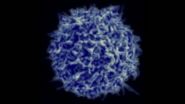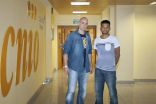(Press-News.org) While investigating a rare genetic disorder, researchers at the University of California, San Diego School of Medicine have discovered that a ubiquitous signaling molecule is crucial to cellular reprogramming, a finding with significant implications for stem cell-based regenerative medicine, wound repair therapies and potential cancer treatments.
The findings are published in the Nov. 20 online issue of Cell Reports.
Karl Willert, PhD, assistant professor in the Department of Cellular and Molecular Medicine, and colleagues were attempting to use induced pluripotent stem cells (iPSC) to create a "disease-in-a-dish" model for focal dermal hypoplasia (FDH), a rare inherited disorder caused by mutations in a gene called PORCN. Study co-authors V. Reid Sutton and Ignatia Van den Veyver at Baylor College of Medicine had published the observation that PORCN mutations underlie FDH in humans in 2007.
FDH is characterized by skin abnormalities such as streaks of very thin skin or different shades, clusters of visible veins and wartlike growths. Many individuals with FDH also suffer from hand and foot abnormalities and distinct facial features. The condition is also known as Goltz syndrome after Robert Goltz, who first described it in the 1960s. Goltz spent the last portion of his career as a professor at UC San Diego School of Medicine. He retired in 2004 and passed away earlier this year.
To their surprise, Willert and colleagues discovered that attempts to reprogram FDH fibroblasts or skin cells with the requisite PORCN mutation into iPSCs failed using standard methods, but succeeded when they added WNT proteins - a family of highly conserved signaling molecules that regulate cell-to-cell interactions during embryogenesis.
"WNT signaling is ubiquitous," said Willert. "Every cell expresses one or more WNT genes and every cell is able to receive WNT signals. Individual cells in a dish can grow and divide without WNT, but in an organism, WNT is critical for cell-cell communication so that cells distinguish themselves from neighbors and thus generate distinct tissues, organs and body parts."
WNT signaling is also critical in limb regeneration (in some organisms) and tissue repair.
"We've shown that WNT signaling is required for cellular reprogramming," said Willert. "Some of the processes that occur during cellular reprogramming resemble those that occur during regenerative processes and wound repair. For example, limb regeneration in organisms like axolotl and zebrafish require cells at the injury site to de-differentiate (change their function) and then rebuild the damaged tissue. WNT is essential for these amazing regenerative processes."
Willert cautioned that "it would be a stretch to say that activation of WNT signaling will allow us to regenerate limbs," but said WNT activation is likely valuable in assisting tissue repair.
A variety of efforts are already underway exploring how to leverage WNT signaling to promote wound healing, such as speeding bone fracture repairs, and even hair growth. "That's not really a wound repair process," Willert said, "but WNT is required for hair growth."
The caveat, he noted, is that "there's a fine line between repairing tissue and promoting cancer growth." Willert said there are efforts underway to create therapeutics that block WNT signaling as a means to block cancer growth. Earlier this year, for example, Willert and colleagues published findings describing the use of an antibody to disrupt WNT signaling in embryonic stem cells. In cancer cells with mutations in the WNT signaling pathway this antibody may inhibit their growth and development.
INFORMATION:
Co-authors include Jason Ross, Julia Busch, Damian Ng, Alexandra Stanley and David Brafman, UCSD Department of Cellular & Molecular Medicine and Sanford Consortium for Regenerative Medicine; Ellen Mintz, California Polytechnic State University; V. Reid Sutton and Ignatia Van den Veyver, Baylor College of Medicine.
Funding for this research came, in part, from the California Institute for Regenerative Medicine (grant RB1-01406), the National Institutes of Health (grant 1R01GM110304-01), the UC San Diego Stem Cell Program and the Eunice Kennedy Shriver National Institute of Child Health & Human Development.
VIDEO:
Researchers at the Salk Institute explain how a new technology, called ReBiL, can spot protein interactions more accurately, providing a new tool for cancer and other drug diagnostics.
Click here for more information.
LA JOLLA--For decades, researchers have struggled to translate basic scientific discoveries about cancer into therapeutics that effectively--and with minimal side effects--shrink a tumor.
One avenue that may hold great potential is the development of ...
Researchers at the RIKEN Brain Science Institute in Japan have identified a key neuronal pathway that makes learning to avoid unpleasant situations possible. Published online in the November 20 issue of Neuron, the work shows that avoidance learning requires neural activity in the habenula representing changes in future expectations.
Learning to avoid threats is an essential survival skill for both humans and animals. To do so, animals must be able to predict a danger and then update their predictions based on their actions and new outcomes. Until now, the neural mechanisms ...
Scientists have created the largest-scale map to date of direct interactions between proteins encoded by the human genome and newly predicted dozens of genes to be involved in cancer.
The new "human interactome" map describes about 14,000 direct interactions between proteins. The interactome is the network formed by proteins and other cellular components that 'stick together.' The new map is over four times larger than any previous map of its kind, containing more high-quality interactions than have come from all previous studies put together.
CIFAR Senior Fellow ...
PHILADELPHIA - Human existence is basically circadian. Most of us wake in the morning, sleep in the evening, and eat in between. Body temperature, metabolism, and hormone levels all fluctuate throughout the day, and it is increasingly clear that disruption of those cycles can lead to metabolic disease.
Underlying these circadian rhythms is a molecular clock built of DNA-binding proteins called transcription factors. These proteins control the oscillation of circadian genes, serving as the wheels and springs of the clock itself. Yet not all circadian cycles peak at the ...
Harvard Stem Cell Institute scientists at Brigham and Women's Hospital have found the cellular origin of the tissue scarring caused by organ damage associated with diabetes, lung disease, high blood pressure, kidney disease, and other conditions. The buildup of scar tissue is known as fibrosis.
Fibrosis has a number of consequences, including inflammation, and reduced blood and oxygen delivery to the organ. In the long term, the scar tissue can lead to organ failure and eventually death. It is estimated that fibrosis contributes to 45 percent of all deaths in the developed ...
Liver cancer is one of the most frequent cancers in the world, and with the worst prognosis; according to the World Health Organisation (WHO), in 2012, 745,000 deaths were registered worldwide due to this cause, a figure only surpassed by lung cancer. The most aggressive and frequent form of liver cancer is hepato-cellular carcinoma (HCC); little is known about it and there are relatively few treatment options.
Researchers from the Spanish National Cancer Research Centre (CNIO), have produced the first mouse model that faithfully reproduces the steps of human HCC development, ...
Mouse cells and tissues created through nuclear transfer can be rejected by the body because of a previously unknown immune response to the cell's mitochondria, according to a study in mice by researchers at the Stanford University School of Medicine and colleagues in Germany, England and at MIT.
The findings reveal a likely, but surmountable, hurdle if such therapies are ever used in humans, the researchers said.
Stem cell therapies hold vast potential for repairing organs and treating disease. The greatest hope rests on the potential of pluripotent stem cells, which ...
A recently discovered protein complex known as STING plays a crucial role in detecting the presence of tumor cells and promoting an aggressive anti-tumor response by the body's innate immune system, according to two separate studies published in the Nov. 20 issue of the journal Immunity.
The studies, both from University of Chicago-based research teams, have major implications for the growing field of cancer immunotherapy. The findings show that when activated, the STING pathway triggers a natural immune response against the tumor. This includes production of chemical ...
Say you ignored one of those "this website is not trusted" warnings and it led to your computer being hacked. How would you react? Would you:
A. Quickly shut down your computer?
B. Yank out the cables?
C. Scream in cyber terror?
For a group of college students participating in a research experiment, all of the above were true. These gut reactions (and more) happened when a trio of Brigham Young University researchers simulated hacking into study participants' personal laptops.
"A lot of them freaked out--you could hear them audibly make noises from our observation ...
November 20, 2014, Chicago, IL - A team of researchers led by Ludwig Chicago's Yang-Xin Fu and Ralph Weichselbaum has uncovered the primary signaling mechanisms and cellular interactions that drive immune responses against tumors treated with radiotherapy. Published in the current issue of Immunity, their study suggests novel strategies for boosting the effectiveness of radiotherapy, and for combining it with therapies that harness the immune system to treat cancer.
"Much of the conversation about the mechanisms by which radiation kills cancer cells has historically focused ...




